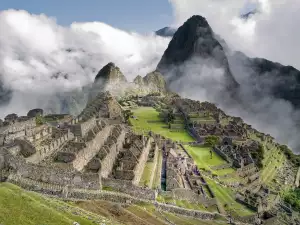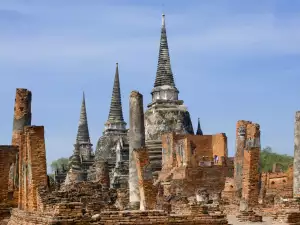12 of the most impressive ruins of the World
1. Machu Picchu (Peru)The most famous of all are the Inca ruins, Machu Picchu was suspended between two mountains and is often surrounded by fog. It can be seen from the Urubamba Valley below and is a magical place, given that the Incas did not even know the wheel when they built it.

The Incas had no script and did not leave written reports, so archaeologists must readd the puzzles, small pieces of evidence show the real reason why Machu Picchu was built, what was served and why it was abandoned so quickly.
2. Babylon (Iraq)
Only 90 kilometers from Baghdad today lay the ruins of ancient Babylon, whose original name can be translated as "The Gateway of the Gods." Babylon is one of the best known ancient cities known for its sophistication, beauty and magnificence. In the past the walls of the city spoke with admiration and reverence, while the Hanging Gardens were recognized as one of the Seven Wonders of the world.
As a cultural and governmental center, Babylon flourished for nearly fifteen centuries, from the arrival of the Amorites (also called amoriti) in 1850 BC, until the time of Alexander the Great, who died there in 322 BC. One of the most famous rulers of the city is great Zakonopisets Hamurabi (1792 - 1750 BC).
3. Palenke (Mexico)
Palenke ruins are among the most important Mayan archaeological sites in the whole of Mexico and Central America. Affixed to the ledge, opposite the coastal plain of the Gulf of Mexico, Palenke is located close to the dense tropical forests of the foothills of the mountain chain troops in Chiapas, Mexico.
Although analysis of the pottery showed that the area was inhabited around 100 BC, most of the buildings we see today were built between the XVI and the tenth century AD.
The greatest ruler of the city is Pakal, who entered the throne in 603 AD and started a boom in innovative architecture buildings what have "outgrown" his 68 year reign. One of the most notable projects was the palace. Its walls and roof are covered with mortar carved images showing the activities and ceremonies of kings and gods, allowing observers of today an insight into the life and beliefs of the Mayans. Another magnificent building is a temple of the inscriptions containing platelets, which describes the long history of the previous rulers.
The real prize of a trip to Palenke is revealing the mysteries. Only 34 of perhaps 500 buildings have been excavated so far.
4. Ayutthaya (Thailand)
Ayutthaya, whose name means "invincible" in Sanskrit, may not be as popular as Bangkok, Phuket and Chiang Mei, but was among the many places in Thailand that are frequented by tourists who want to have a glimpse of Thailand’s world famous ruins.

5. Colosseum (Italy)

The Colosseum can accommodate 50,000 people and was used as an arena for gladiator fights and public spectacles, such as sea battles, hunting other animals, executionsm repetitions of certain battles and dramas based on classical mythology. Around 500,000 people and more than a million wild animals were killed during the performances in the Colosseum.
Although in the XXI century the building was partially destroyed because of devastating earthquakes and because of thieves, the Colosseum is an icon of the Roman Empire and is a breakthrough in construction. It is one of the most popular tourist attractions in the Italian capital.
6. The ruins at Tikal (Guatemala)
Tikal is one of the greatest archaeological sites and urban center of the Mayan civilization from the time before Columbus. Situated in the archaeological region of Bass in northern Petén Guatemala. Part of the Tikal National Park in Guatemala and in 1979 was included in the List of World Heritage by UNESCO.
Tikal was one of the major cultural and population centers of the Maya. Though monumental architecture dates from IV century BC, Tikal reached its apogee during the classical era, from 200 to 900 AD, when there was a political, economic and military domination over the region and also interacted with areas across Mesoamerika such as Mexico Teotiuakan center. There is evidence that Tikal was conquered by Teotiuakan in the IV century.
At the end of the late classical era new major monuments were built at Tikal and there is evidence that the most important palaces were burned. These events combined with a gradual decline in population, following the abandonment of the city during the X century.
7. Chichen Itza (Mexico)
Chichen Itza is a huge archaeological site from the time before Columbus, built by the Mayan Civilization located in the north central part of the Yucatan Peninsula in the state of Yucatan, Mexico.
It was a major regional center in the northern lands of the Mayans of the late classical era to the end and also during the early years of the early classic era. The site reveals many architectural styles that are reminiscent of those in central Mexico. One particular style was once considered the evidence of migration or even the expansion of central Mexico, but most contemporary interpretations accept the presence of these styles result from the dissemination of culture.
8. Parthenon (Greece)
The Parthenon is the temple of the Greek goddess Athena and was built in V century BC on the Acropolis in Athens. It is the most important preserved building from the classical Greek period, primarily considered the culmination of the development of Doric. The sculptures, used for decoration, are considered the peak of Greek art. The Parthenon was adopted as the immortal symbol of ancient Greece and of Athenian democracy, and one of the greatest cultural monuments in the world. The Greek Ministry of Culture is currently on program for reconstruction and the restoration of the temple.
9. Jesuit ruins at Trinidad (Paraguay)
Located 25 km from Enkarkasion (South Paraguay), on the way to Suidad del Este, Jesuit ruins are the most interesting and most famous ancient ruins of eight churches in Paraguay.
Trinidad was founded by local people, who came from the church in San Carlos. Its main architects were Juan Bautista from Milan and Jose Catalan Grimau. The church, though incomplete, is one of the largest and most beautiful, according to notes of travelers from that period.
After crossing the nave of the old church, you will see an impressive view of the decorations on the wall above the altar, each stone of which is decorated and complemented by a number of angels with instruments in baroque style. The two doors that give access is where they held ecclesiastical garments. Worth mentioning: the columns and capitals have disproportionate triple line extensions supporting the frieze, two side columns and sculpture in the middle ground. From the west side are the ruins of the tower and the long chapel. The square tower is a reminiscent of the fort and we do not know whether it was a bell tower or observatory, or both. The chapel was probably used until the main church was built. It now contains a small museum with local inputs (in authentic color) and a sketch of the church. In 1993 it was added to World Heritage by UNESCO.
10. Ruins of the Copa
Capital of the Mayan between 400 - 800 years AD, Copa is one of the largest and most impressive Mayan centers, found so far. It consists of pyramids, temples and 21 stone columns exquisitely engraved with representations of the ancient kings of the dig. Although Tikal in Guatemala is the largest known Mayan city to us and is more easily accessible. However Copa must not be overlooked by anyone who is interested in the Mayan civilization.
11. Ruins of Palmyra (Syria)
In the heart of the Syrian desert, Palmyra is often described as the desert bride. It’s stories remain remarkable with heroic history during the reign of Queen Zenobiya. Oasis, as is sometimes referred to as the place was built near the mineral spring Afka, making it an ideal stopover for caravans passing between Iraq and Al-Pistachio (modern Syria, Lebanon, Jordan and the Holy Land) that carried silk from China to the Mediterranean.
Palmyra's strategic position and its prosperity attracted the interest of the Romans to conquer the city during the first century AD. The fate of the great Kingdom of Palmyra was no happier than that of his queen: Zenobiya who was defeated and captured in Rome and bound in golden chains. There she was poisoned, and the town was plundered and destroyed. Archaeologists are still working on excavations to find the queen's palace which was destroyed by the Romans.
12. Talisay (Philippines)
In the town of Talisay in the Philippines was built by sugar magnate in the early last century, which had twice been destroyed during World War II so Japanese forces could not use it. Apart from the Philippines, the U.S. Air Force bombarded the housing area and the Philippine rebels burned it to the ground to save it from falling into Japanese hands.
